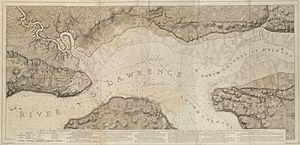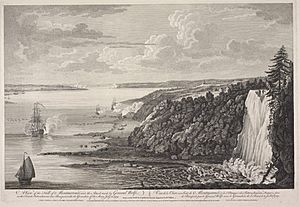Battle of Beauport facts for kids
Quick facts for kids Battle of Beauport |
|||||||
|---|---|---|---|---|---|---|---|
| Part of the French and Indian War | |||||||
 A 1777 map showing where the French and British armies were during the Siege of Quebec. |
|||||||
|
|||||||
| Belligerents | |||||||
| Commanders and leaders | |||||||
| James Wolfe | Marquis de Montcalm | ||||||
| Strength | |||||||
| 4,000 regulars | ~10,000 regulars and militia | ||||||
| Casualties and losses | |||||||
| 210 killed 233 wounded |
60 dead or wounded | ||||||
The Battle of Beauport, also called the Battle of Montmorency, happened on July 31, 1759. It was a major fight between the British and French Armed Forces during the Seven Years' War. This war is also known as the French and Indian War in North America. The battle took place in the French area of New France.
The British, led by General James Wolfe, attacked the French defense line near Beauport. This area was about 5 kilometers (3 miles) east of Quebec. The French stopped the British attack. General Wolfe's soldiers had to retreat, losing 443 men who were either killed or wounded.
Contents
Why the Battle Happened
The year 1758 was mostly good for the British in the French and Indian War. They sent over 40,000 soldiers to New France. They won important battles, like capturing Louisbourg and destroying Fort Frontenac. However, the French general Louis-Joseph de Montcalm stopped their main attack at the Battle of Carillon.
William Pitt, a British leader, wanted to keep fighting hard in 1759. He planned big attacks on the main parts of New France. These were the Canadian communities of Quebec and Montreal along the St. Lawrence River. For the attack on Quebec, General James Wolfe was put in charge of about 7,000 soldiers.
The Beauport Defenses
When General Wolfe arrived near Quebec on June 26, he saw something important. The northern shore of the St. Lawrence River around Beauport was very well defended. This was the best place for troops to land.
The French had built strong defenses there. They had dug trenches on high ground and built small forts called redoubts. They also had floating batteries (boats with cannons). Because of these strong defenses, Wolfe had to find another place to land his soldiers. He spent weeks looking for the best spot.
Setting up Camp at Montmorency
On the night of July 8 or 9, British soldiers landed on the north shore. This was about 1.2 kilometers (0.75 miles) east of the Montmorency Falls. This spot was also east of where the French defense line ended. General Wolfe landed first, leading his best soldiers. Other troops followed him.
The French did not try to stop this landing. The British set up a camp near where they landed. Wolfe ordered a cannon battery to be built to protect the camp. He also had rafts and floating batteries made. These were for a future attack on the French defense line.
Wolfe's Attack Plans
After setting up the Montmorency camp, Wolfe thought about different ways to attack. He decided on his main plan on July 28. He had considered two main ideas before this.
His first plan, from July 16, was to capture a French redoubt. This was a small fort on the eastern end of the Beauport line. He hoped this would force the French out of their trenches. This plan involved the Navy attacking, a large landing force from Île d'Orléans, and troops crossing the Montmorency River on rafts. At the same time, another group of soldiers would land further west, between the Saint-Charles River and Beauport.
This plan changed on July 20. The Royal Navy managed to sail seven ships past Quebec. This opened up the chance to land soldiers west of Quebec. French cannons and floating batteries could not stop the British ships.
Wolfe then thought about landing near the village of Saint-Michel. But he quickly changed his mind again. He told his officers to wait for "particular circumstances." This might have been because a new French cannon battery damaged one of his ships.
Wolfe returned to the Montmorency camp on July 26. He walked up the Montmorency River to check the French lines. About 5 kilometers (3 miles) from the river's mouth, he found a place where soldiers could easily cross the river. This led to a fight between British and French soldiers. The British reported 45 men killed or wounded.
On July 28, Wolfe planned an attack on the Beauport line for July 30. But bad winds stopped the ships from moving. So, the attack was moved to the next day. This final plan was a bit different from his earlier ideas. It did not include a landing west of Beauport.
Who Fought
Here are the main forces involved in the battle:
British Forces
The British forces were led by Major General James Wolfe. He commanded fewer than 5,000 men.
- Elite Grenadiers: 13 companies of grenadiers (specialized soldiers) from various regiments.
- Royal Americans: 2 companies (200 men) from the 60th (Royal American) Regiment of Foot.
- Monckton's Brigade: Led by Brigadier General Robert Monckton.
- 15th Regiment of Foot
- 78th Fraser Highlanders
French Forces
The French forces were led by Brigadier General Louis Joseph de Saint Véran, Marquis de Montcalm. He had about 12,000 regular soldiers and militia. However, only a part of his army (the left side) fought in this battle.
- Extreme Left Wing: Commanded by Colonel Repentigny, with 800 volunteers.
- Left Wing: Commanded by Colonel François-Gaston, Chevalier de Lévis.
- Battalions from the Béarn, Guyenne, and Royal Roussillon regiments.
- La Sarre Grenadiers (1 company).
- A mixed group of Montréal militia and regular troops.
- Montréal Militia.
- Trois-Rivières Militia (in reserve).
- 500 Native allies.
The Battle

A Risky Plan
On the morning of July 31, a British warship, the Centurion, moved near the Montmorency Falls. It began to fire on the easternmost French cannons. General Wolfe was on another ship, the Russell, which was part of the attack.
From the ship, Wolfe could see the French positions better. He quickly realized he had made a mistake. The small fort (redoubt) he wanted to capture was within easy reach of French cannons. The French soldiers could shoot at the redoubt without leaving their safe trenches on the high ground. This made Wolfe's plan much riskier than he thought.
Even so, General Wolfe decided to continue the attack. He wrote in his journal that he saw "confusion and disorder" among the French. This made him think they were ready to be attacked. He ordered his other commanders to get ready for the attack.
A Difficult Landing
Around 11:00 AM, the transport ships reached the north shore. The soldiers meant to take the redoubt landed first. Around 12:30 PM, the main group of landing boats left Île d'Orléans to meet Wolfe.
But there was an unexpected problem. The boats hit a shoal (a shallow area) and could not reach the shore. A lot of time was lost trying to find a good landing spot. Finally, the main landing happened around 5:30 PM. By then, storm clouds were gathering in the sky.
The Fight Begins
The first British troops to move toward the French lines were the grenadiers and about 200 Royal American soldiers. They tried to advance up the hill to the French trenches. However, fire from the Montreal militia stopped their progress.
Soon after the fighting started, a summer storm broke out. The rain made the gunpowder wet, so the firearms could not be used. When General Wolfe ordered the retreat, the troops from the Montmorency camp had not even met up with the main force yet.
What Happened Next
The French won the battle. General Wolfe reported that the British had 443 losses. This included 210 killed and 233 wounded. The French, on the other hand, had only 60 killed or wounded. Their losses were mostly from the cannons at the Montmorency camp. The day after the battle, Wolfe wrote that the losses were not huge and that the defeat was not a reason to give up.
The French celebrated their victory. But General Montcalm was still thinking clearly. He believed this attack was just a small part of a bigger one that was coming. He knew they had to wait patiently.
The bigger attack did come later. On September 13, the British landed west of Quebec. They defeated the French on the Plains of Abraham. In that battle, both Montcalm and Wolfe were killed.
Images for kids
See also
 In Spanish: Batalla de Beauport para niños
In Spanish: Batalla de Beauport para niños



